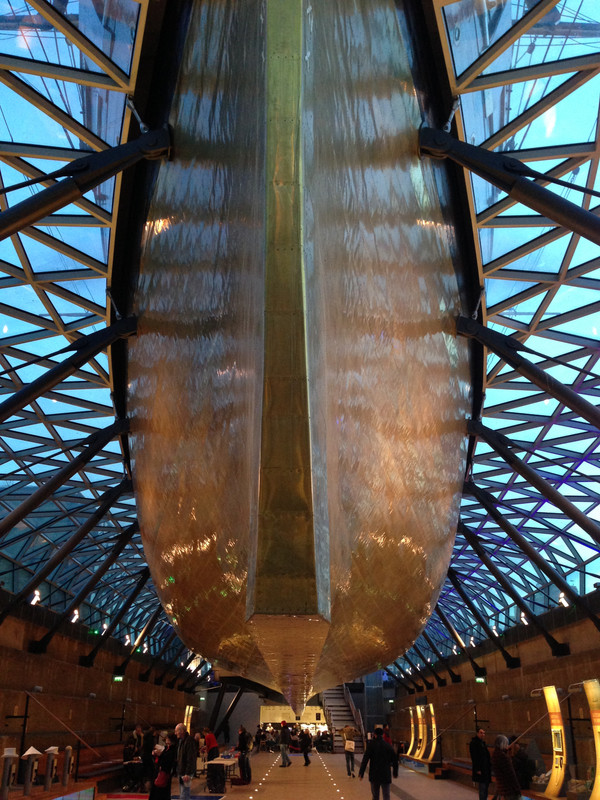Home › Forums › Chat Forum › 2021 America’s Cup
- This topic has 428 replies, 51 voices, and was last updated 2 years ago by Twodogs.
-
2021 America’s Cup
-
matt_outandaboutFull MemberPosted 4 years ago
Britannia, the UK boat 2 and actual race boat now launched.
Looks amazing… Come on Mr_sir_Ainslie and co.
roverpigFull MemberPosted 4 years agoPity they are going to stick a bloody great advert for ineos on top of it
jimwFree MemberPosted 4 years agoIt must be in the eye of the beholder…. to me that is just ugly.
But this on the other hand was just beautiful..to me. And I have been aboard her but never likely to get on Brittania
I have also sailed on the 12 metre Gretel , the 1962 challenger in Australia, also much more classically beautiful.
matt_outandaboutFull MemberPosted 4 years agoIt must be in the eye of the beholder…. to me that is just ugly.
Yes.
But it looks fast. Just look at it.
They fly.
eddiebabyFree MemberPosted 4 years agoThat foiling tack was pretty impressive. I’d still rather they went to the non foiling monohulls and hold the event in shifty winds but I accept I’m an old school dinghy sailor.
zaneladFree MemberPosted 4 years agoYou’re not alone jimw. The Js and similar boats were elegant, but to me the 12 Metres are beautiful. Timeless craft that seem to defy aging. I liked the charachters that sailed them too. Turner, Conner, Blackaller and even the steely eyed upstart Dickson. Plus match racing in 12s is far more appealing to me than drag racing.
jimwFree MemberPosted 4 years agoTimeless craft that seem to defy aging.
Exactly. The two hours I spent helming Gretel on a shy spinnaker reach off the Whitsunday Islands in 1995 was one of the best sailing experiences I ever had.
But it looks fast. Just look at it.
Undoubtedly, but it is the same as comparing a modern F1 car to a Maserati 250F. I know which I prefer to watch ( and listen to) One was developed when F1 was a sport, the other when it is a business.
convertFull MemberPosted 4 years agoAs a lifelong sailor I’m trying to a take an interest but……….meh
A stupid money business of a sport looking ridiculously incongruous in the current global situation and the UK effort is sponsored by a pretty unpleasant company that also looks like a dinosaur to the direction of travel most of would hoped were were travelling in term of the environment and sustainability before the world got covid bolloxed.
So, I’m out.
choppersquadFree MemberPosted 4 years agoThey’re more hovercraft than boat.
I know nothing at all about boats but I do know that when I was a kid I used to draw boats touching the water.
I’ve turned into my Dad.dovebikerFull MemberPosted 4 years agoI spent a morning sat aboard Valsheda (J-Class) in the port of Douarnenez in 1988 drinking G&Ts – hoping to go for a sail – unfortunately the owner’s daughter had bunked-off with a crew-member overnight so we didn’t go anywhere. She did go out in the afternoon – I was on another boat and it was impressive to watch her sail by.
matt_outandaboutFull MemberPosted 4 years agoAaaaa and it’s nearly Vendee Globe time
Which actually interests me more..
TwodogsFull MemberPosted 4 years agoIt must be in the eye of the beholder…. to me that is just ugly.
I guess it depends if you value form over function. Thank god the days of the old America’s Cup are over…2 boats drifting around 20 miles offshore with no-one having a clue what is going on. The competition in San Francisco Bay was genuinely exciting, and the new boats are designed to do one thing…go bloody fast on all points of wind, and as a result they look stunning IMHO.
chrismacFull MemberPosted 4 years agoHow much stuff must they sell to make sponsoring something this expensive pay?
fogliettazFree MemberPosted 4 years agoVendee Globe for me as well, it will have have me captivated for 70-ish days. Hopefully travel restrictions will have been lifted so I can go and welcome the victors back to Les Sables d’Olonnes.
bobloFree MemberPosted 4 years agoI was ganna see them off in a couple of weeks but COVID-19 has put paid to that. We’ve sneaked one France trip in this year and that’s it. Normally at least monthly 🙄
jimwFree MemberPosted 4 years agoI guess it depends if you value form over function.
Oh, I can admire their singleminded purpose but do they look good?.. no
As for form over function?
Are they fast? Yes, but that is all they can do. You could argue that is their purpose, but at what cost, both in monetary terms and long term value?
Endeavour crossed the Atlantic under sail to take part in the America’s Cup, so was seaworthy. And yes I do know that she nearly bankrupted TOM Sopwith. But she is still sailing. Gretel was a successful racer in a number of long distances races including the Sydney-Hobart race and then a charter boat for many years earning a living. Would Someone be able to have a day sail on Britannia in 2043 and have a great day out? I doubt it.CountZeroFull MemberPosted 4 years agoI was looking at a still from that video earlier, and one thing that struck me was the underside of the hull looks exactly like the underside of the hull of the Cutty Sark!

Seeing as how fast the tea clippers were, there must be a hydrodynamic reason for having that flat centre part of the keel running back from the bow.
sharkbaitFree MemberPosted 4 years agoAll I’ll say is that it wasn’t that long ago that 30knts was the holy grail for sail raft…. And these suckers are doing 50knts – it’s amazing.
That said I think the foiling cat racing of the last AC will be hard to beat from a viewing perspective. But I was rooting for the NZ guys so slightly biased.As technically superb these boats are I’m not entirely sure about how good the racing will be.
The 12m looked nice but the racing was utterly crap to watch.hols2Free MemberPosted 4 years agoAmazing how much water that J class boat is shifting – all that power going towards literally ploughing a hole through the sea, whereas the foiling boats are just skimming across the surface. Unfortunately, the fast boats look incredible on TV and that’s what they need to get non-enthusiasts to watch to attract sponsors to pay for it all. I just dread what’s gonna happen if one of them crashes at high speed.
bentudderFull MemberPosted 4 years agoThe bottom of that looks like an old pre-foiling International Moth – basically one long planing surface.
As a (now retired) foredeckie, I slightly resent the loss of spinnakers in racing. Asyms are fun and all, but need less knitting and hopscotch skills up front.
On the plus side, the speed of these things means that tactics and strategy are more easily seen and discussed with non-sailors.
I’m toying with getting back into dinghies as my oldest is really getting into his sailing and I don’t have the time to devote to getting good enough for bigger boat series; if I can’t spare the time, I don’t want to curse the rest of my crew with my declining skills…bobloFree MemberPosted 4 years agoBut I was rooting for the NZ guys so slightly biased.
Need to be very careful using the word ‘rooting’ in an Antipodean context… 😝
KahurangiFull MemberPosted 4 years agoDoesn’t look like the Brittannia’s port and stbd foils lift, like we see the Emirates doing? Is it a generation behind?
And what’s Ratcliffe doing calling it “Brittannia” after moving residency to. Monaco? He’s got some nerve.
thisisnotaspoonFree MemberPosted 4 years agoSeeing as how fast the tea clippers were, there must be a hydrodynamic reason for having that flat centre part of the keel running back from the bow.
Based on the first generation I think it’s to keep it stable in intermediate conditions. As it lands you want the wetted surface to be minimal and increase gradually, otherwise it will slow down too much then the surface friction means there’s a huge hump to get over to take off again.
The outer dimensions of the hull are strictly controlled (so you end up with something that looks like a “boat”) by the rules otherwise I suspect they’d have ended up closer to very narrow scows.
There was an argument over the wind conditions that would be allowed for racing. Obviously, there’s an upper limit, but you need to know the lower limit so you know whether you need to design the “hull” to work in the water, or whether you can focus on it being merely an aerodynamic fuselage (remember they’re doing 50mph, the aerodynamics are important). Judging by that hull they’ve decided there’ll be some racing in the water not just on it.
Doesn’t look like the Brittannia’s port and stbd foils lift, like we see the Emirates doing? Is it a generation behind?
The lifting arms and mechanism are a one-design part to keep them strong enough. Just the foils on the end are unique.
TwodogsFull MemberPosted 4 years agoFoiling is the future of light wind sailing…having started windfoiling in the last couple of months, I’m getting on the water way more…and 20kts in 10kts of wind is fantastic (and I’m only a beginner at it). A bit “exciting” when the foil breaks the surface and you crash down…
sharkbaitFree MemberPosted 4 years agoIf that video is supposed to make the team look good it’s an epic fail.
The “Patriot” name is typically American and lame.thols2Full MemberPosted 4 years agoThe “Patriot” name is typically American and lame.
I heard there was a war one time where the American side called themselves “Patriots”. Americans might have a different emotional reaction to it than Loyalists.
yetidaveFree MemberPosted 4 years agoanyone heard an explanation into the holes in the side of Britannias hull on the bustle just behind the foil arm? cockpit drains maybe, but surely they would cause drag? or is there some form of ventilation thing going on generating pressure under the hull?
matt_outandaboutFull MemberPosted 4 years agoI had the same question – and assumed it was ventilation of some kind, like steps on a powerboat.
eddiebabyFree MemberPosted 4 years agoFoiling is the future of light wind sailing…having started windfoiling in the last couple of months, I’m getting on the water way more…and 20kts in 10kts of wind is fantastic (and I’m only a beginner at it). A bit “exciting” when the foil breaks the surface and you crash down…
Envious! I was promised some time on a foiling board this summer in Portland Harbour but then Covid happened.
sharkbaitFree MemberPosted 4 years agoI had the same question – and assumed it was ventilation of some kind, like steps on a powerboat.
Interesting. At first I thought that they were there to introduce air to break up the laminar flow [that is normally a good thing on no-foiling boats] and allow the hull to ‘unstick’ earlier and hence foil quicker.
But I’d have thought, in that case, that the holes would run down the hull towards the keel….. so, I have no idea.
Seems an odd place for drainage to exit though.matt_outandaboutFull MemberPosted 4 years agoAnd odd to have 3(?) down each side, and not seemingly shaped to cause minimal disturbance? Perhaps they just expect to foil the vast majority of time.
You must be logged in to reply to this topic.


